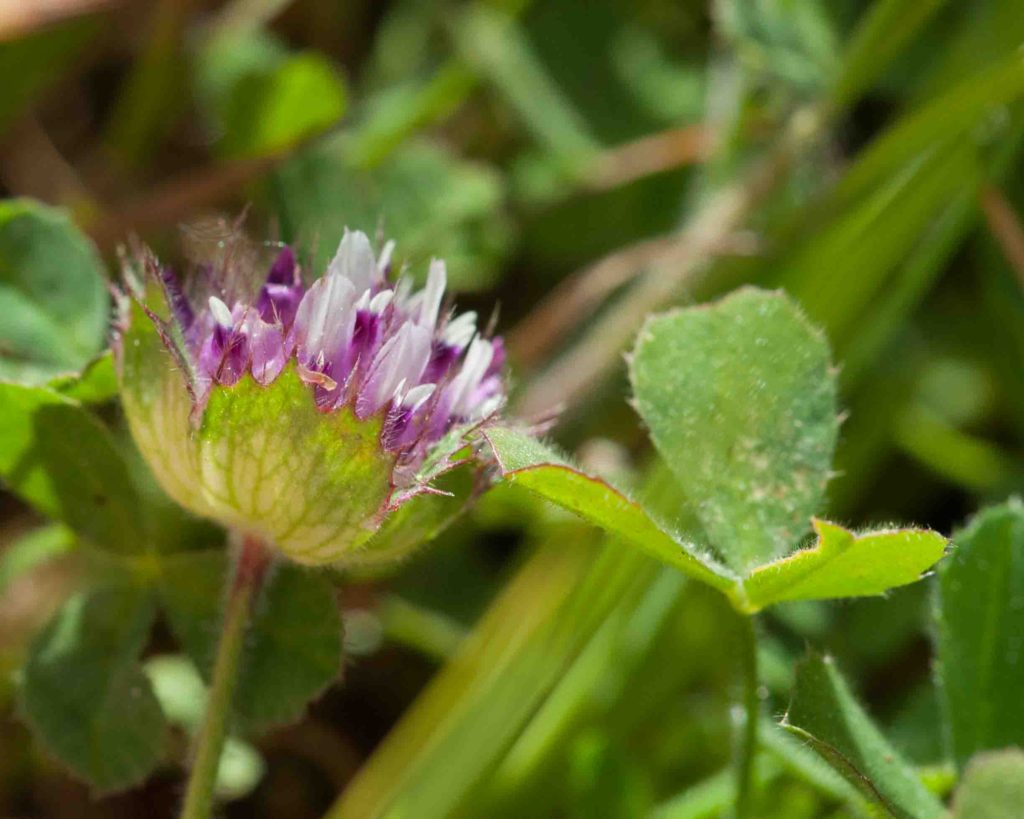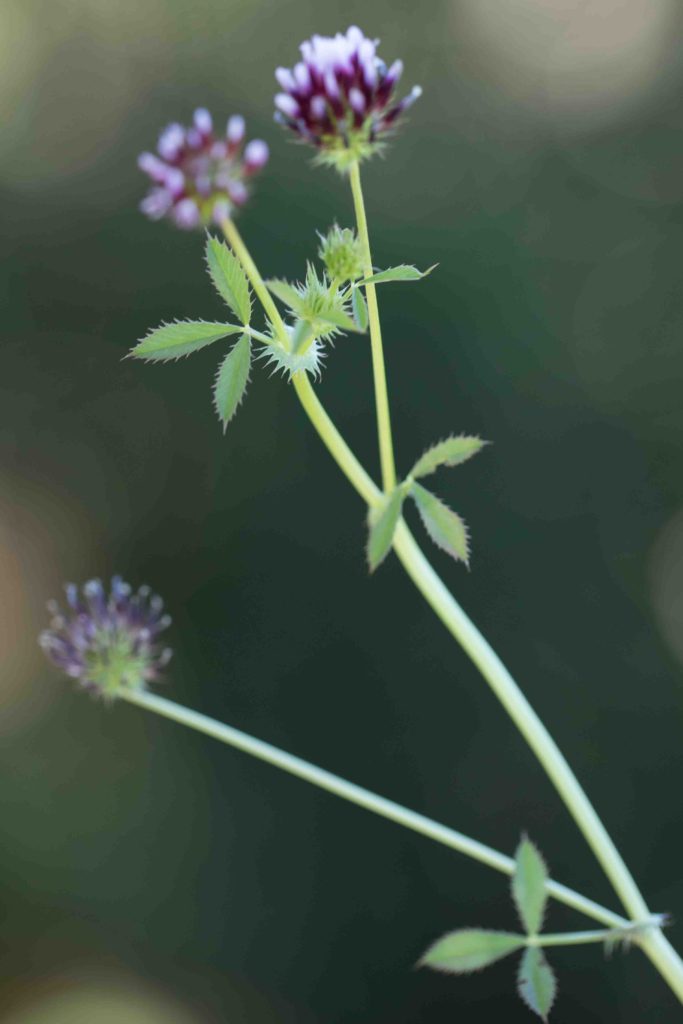Fabaceae: Pea Family — Trifolium (Clover): flower heads with involucre
The pea family has 5-petaled flowers, consisting of a wide upper banner petal, two wing petals, plus two lower petals which are fused to form a boat-shaped keel. Many produce heads or spikes, consisting of multiple individual flowers (examples are lupines and clovers). The seed pod is generally a “legume”. This is a long, flattish pod, swollen by the seeds, and splitting lengthwise along both the top and bottom.
Clovers are common, small plants, sometimes with subtle differences. In reading about a clover, remember that the flower head is made up of many small individual flowers. So if a description says that the calyx lobe is longer than the flower, examine the individual flower’s calyx. Identifying clovers is simplified by looking to see if they have an involucre: bracts at the base of the head which are fused to form a cup, bowl or wheel. About 40% of the clovers found in Monterey County have involucres; all of these are native. This page covers the plants with involucres.
Bearded Clover – Trifolium barbigerum
Blooms:
Apr–June
Plant Height:
Small
Flower Size:
Medium
Origin:
Native
Habitat:
Open, low moist places
Notes:
Flowers are red to purple, usually with a pale tip. Calyx lobes are plumose, linear and equal to or longer than the corolla. The involucre is prominent and bowl-shaped, the lobes with toothed edges. The inflorescence is 5–25 mm wide. The peduncle is hairy, and 4–9 cm long.
Pale Sack Clover – Trifolium depauperatum var. amplectens
Blooms:
Apr–June
Plant Height:
Very small
Flower Size:
Small
Origin:
Native
Habitat:
Grassland, coastal woodland
Notes:
This species is characterized by its very small heads, and by the way its banner inflates in fruit to create a sack-like appearance. This variety has very pale greenish-white flowers. The involucre is evident but not prominent.
Dwarf Sack Clover – Trifolium depauperatum var. truncatum
Blooms:
Apr–June
Plant Height:
Very small
Flower Size:
Small
Origin:
Native
Habitat:
Grassy flats, disturbed slopes, woodland openings
Notes:
This species is characterized by its very small heads, and by the way its banner inflates in fruit to create a sack-like appearance. This variety has reddish-purple flowers. The involucre is evident but not prominent, with the lobes more or less free (see photo #3). Photo #3 by CJH.
Sour / Bull Clover – Trifolium fucatum
Blooms:
Apr–June
Plant Height:
10–25 cm
Flower Size:
Medium
Origin:
Native
Habitat:
Moist, brackish places
Notes:
Like the Sack Clovers (Trifolium depauperatum, see above), this is characterized by the way its banner inflates in fruit to create a sack-like appearance. The flower color is quite variable. It may be creamy white, pale yellowish-green, or pink-tinged with deep purple/black spots on the wings. The involucral bracts are prominent but more or less free. Leaves are elliptic to round, and may be finely serrated.
Gray’s Clover – Trifolium grayi
Blooms:
Apr–June
Plant Height:
Small
Flower Size:
Medium
Origin:
Native
Habitat:
Wet meadows, foothill slopes, pine woodland
Notes:
Very similar to Bearded Clover (Trifolium barbigerum, see above), and formerly treated as a variety of it. They both have a prominent, bowl-shaped involucre (sometimes more saucer-shaped) with sharply toothed lobes, and long, plumose calyx lobes. Unlike Bearded Clover, the calyx lobes are shorter than the corollas.
Maiden / Small-headed Clover – Trifolium microcephalum
Blooms:
Apr–Aug
Plant Height:
Small
Flower Size:
Medium
Origin:
Native
Habitat:
Streambanks, moist, disturbed areas
Notes:
Stems are erect to decumbent. Flower heads are small, with 4–7 mm rose to whitish flowers with bristle-tipped calyx lobes. The involucral lobes are deeply cut. Both stem and inflorescence have fine wavy hairs.
Creek / Clammy Clover – Trifolium obtusiflorum
Blooms:
Apr–July
Plant Height:
Medium
Flower Size:
Medium
Origin:
Native
Habitat:
Streambeds and other moist places
Notes:
This has comparatively large flower heads (1.5–3 cm across), The flowers are 14–18 mm tall, whitish-pink with purplish blotches on the wings. The sharply serrated 2–4 cm long leaflets are distinctive. The involucre is deeply cut, and the plant is sticky with short, glandular hairs.
Pacific Grove Clover – Trifolium polyodon
Blooms:
Apr–June
Plant Height:
Medium
Flower Size:
Medium
Origin:
Native
Rare or endangered?
Yes – 1b.1
Habitat:
Closed-cone pine forest, moist meadows, streamsides
Notes:
This rare clover is endemic to the Monterey peninsula, found in Del Monte Forest, Fort Ord and of course Pacific Grove. It is similar to White-tipped Clover (T. variegatum, see below), but is distinguished by its calyx lobes, which typically have at least one lobe 2- or 3-parted. The flower heads are are 8–10 mm in diameter, pink with white (purple) tips. The wheel-shaped involucre is cut more or less to the center. Leaves are widely elliptic to obovate with rounded tips. Stipules are deeply cut.
White-tipped Clover – Trifolium appendiculatum
Blooms:
Apr–July
Plant Height:
Medium
Flower Size:
Small
Origin:
Native
Habitat:
Permanently wet places
Notes:
This plant is uncommon in Monterey County, but found in Fort Hunter Liggett and the Indians. In appearance, it is similar to Tomcat Clover (Trifolium willdenovii, see below). However, it can be distinguished by the pale pink to whitish tips of the flowers, and by the more ragged appearance of its involucral lobes. The species has three varieties found in the county, this being the one with the most flowers (10–many) in the head. The lower leaf stipules are generally entire, the upper ones are deeply cut. Formerly named Trifolium variegatum var. major.
Tomcat Clover – Trifolium willdenovii
Blooms:
Mar–June
Plant Height:
Small
Flower Size:
Medium
Origin:
Native
Habitat:
Widespread, many communities
Notes:
A very common clover, most easily recognized by its narrow lanceolate leaflets and sharply dissected, wheel-like involucre. Flowers are purple with white tips. Photo #3 by CJH.
Cow Clover – Trifolium wormskioldii
Blooms:
May–Oct
Plant Height:
Small
Flower Size:
Medium
Origin:
Native
Habitat:
Generally coastal in wet places
Notes:
A low-growing plant, with ascending stems and a comparatively large flower head. Sometimes found in large quantities. Its pale pink, occasionally white-tipped flowers are distinctive, as is its many-lobed, wheel-shaped involucre. Leaflets are slightly serrated with bristly teeth. Photo #1 by CJH.










































